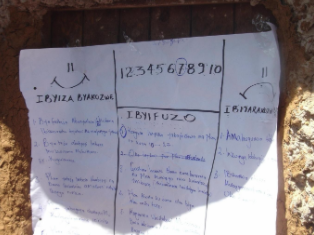Feedback can be simple. I recently learned that a simple feedback tool I designed over three years ago is still going strong and is about to be scaled up massively. At the time I led the M&E for a flagship programme with Plan International UK where I developed a range of feedback tools, but one in particular sought feedback not only from people our intervention targeted, but also from those we had not intended on affecting. This simple tool was made of two parts: gathering feedback and a ribbon ceremony.

H frame feedback from a group of women in Rwanda.
Firstly community members, in groups by age and sex, discussed and presented their feedback using an H frame: things they appreciated, things they did not, their suggestions and an overall score for the programme (figure 1). After girls, boys, women and men had all presented their feedback, our staff responded as much as they could. To symbolise our commitment to closing the feedback loop, we would tie a ribbon to a tree and promise we would return to respond and together untie it when we had answers for the issues that couldn’t be addressed there and then.
When I first proposed this tool there were many questions: what if they ask things we can’t do? What if the donor is unwilling to change the budget? And even: what if somebody steals the ribbon?
This tool was implemented in seven countries in Africa and Asia and soon we learned to deal with all those issues and many more, but what was more fascinating was what we saw through it. “With this tool… we learned about the real needs of a group.” Village leader, Cambodia.
Whether tying a ribbon to a tree or not, consistently closing the feedback loop builds trust not only in the process but within communities as well, and can be the beginning of lasting change.
With a flipchart and some pens and cheap ribbon from the pound shop we saw a transformation, totally unexpectedly. Big budgets don’t necessarily empower citizens to raise their voices, but making a bid deal out of our ribbon ceremony – a promise seen right at the centre of the village for everyone to see – did.
- Project-specific feedback isn’t everything. Communities will talk about their experiences never in relation to a specific project, let alone a specific donor. At first we found this problematic because we developed this tool for a specific project for a donor keen on feedback but we weren’t too sure what to do with feedback for a donor that had not asked for it. Soon we realised that if we are truly committed to accountability we might have to advocate for it, and regular practice with feedback mechanisms is the only thing that will provide ammunition for our argument.
- Learning to give actionable feedback can be a turning point for communities. Once communities started trusting feedback would be answered, we discovered there were many things they wanted that were beyond our project’s scope. For example, could we provide infrastructure and services the State was not? But whenever we turned down the request, our explanation spurred them forward. In Cambodia, the Constituency Voice tool, now rolled out nationally, helped communities realise the importance of actionable asks. Asking for something that is clear if it had or hadn’t been actioned, would avoid elusive answers. Before too long they also realised that requests are better laid at the doorstep of those with the power to take action, and asked us to take along to our sessions district officials from the various ministries responsible for providing infrastructure and services, like the district health official to ask for more services at the clinic, or education to ask for better library in the school.
- Accountability breeds accountability. When I piloted this tool in Kenya some student representatives were among the participants. When I tied the ribbon to the tree promising ‘I will come back with the answers I don’t currently have because we respect what you have raised as an issue‘. It dawned on them that they wanted to be able to say the same thing to the students who had elected them. They resolved there and then to start reporting back both successes and failures to their fellow students.
In Cambodia the communities reported that the tool was “building trust with each other because they now know the mechanism for responding to their specific concern”. Even more transformational was the realisation that the ribbon ceremony taught communities they have a ‘right to be heard’. That is not to say a right to change everything, but a right to ask – and to get an answer. In a country scarred by a brutal past, this realisation is indeed a breakthrough.
As for me my greatest satisfaction is not that my little tool continues to be used, but is to have played a part, however small, in helping some communities find their voice and raise it as high as they can… and as far as I know, nobody ever stole the ribbons.
“The Constituency Voice tool is very useful because it gives the villagers the opportunity to raise and our many issues and we able to know that who will be involved in addressing those issues.” Girl age 15, Cambodia
 Laura is a passionate advocate for putting the voices, needs and aspirations of beneficiaries at the centre of programme development, recognising and enabling children and young people as active citizens. She continues to write and present on issues of rights, gender, participation and accountability.Laura Hughston is a pioneer developer of child-centred monitoring and evaluation practices. She was the very first to lead children, in Cambodia, Zimbabwe and Kenya, to select evaluation questions, collect and analyse data in order to deliver a full evaluation on all DAC criteria: results, effectiveness, efficiency, relevance, sustainability and equity. She has extensive experience of developing and implementing programmes across a wide variety of thematic areas, including gender, governance, education, livelihoods and health. During her time with Plan international UK Laura focused on creating strong monitoring and evaluation systems blending robust quantitative data with practical and creative methodologies for bringing the voices of beneficiaries, especially children, at the forefront of programme quality. She developed a visual tool that places outcomes for communities at the centre of Value for Money analysis and created a range of feedback mechanisms.
Laura is a passionate advocate for putting the voices, needs and aspirations of beneficiaries at the centre of programme development, recognising and enabling children and young people as active citizens. She continues to write and present on issues of rights, gender, participation and accountability.Laura Hughston is a pioneer developer of child-centred monitoring and evaluation practices. She was the very first to lead children, in Cambodia, Zimbabwe and Kenya, to select evaluation questions, collect and analyse data in order to deliver a full evaluation on all DAC criteria: results, effectiveness, efficiency, relevance, sustainability and equity. She has extensive experience of developing and implementing programmes across a wide variety of thematic areas, including gender, governance, education, livelihoods and health. During her time with Plan international UK Laura focused on creating strong monitoring and evaluation systems blending robust quantitative data with practical and creative methodologies for bringing the voices of beneficiaries, especially children, at the forefront of programme quality. She developed a visual tool that places outcomes for communities at the centre of Value for Money analysis and created a range of feedback mechanisms.







